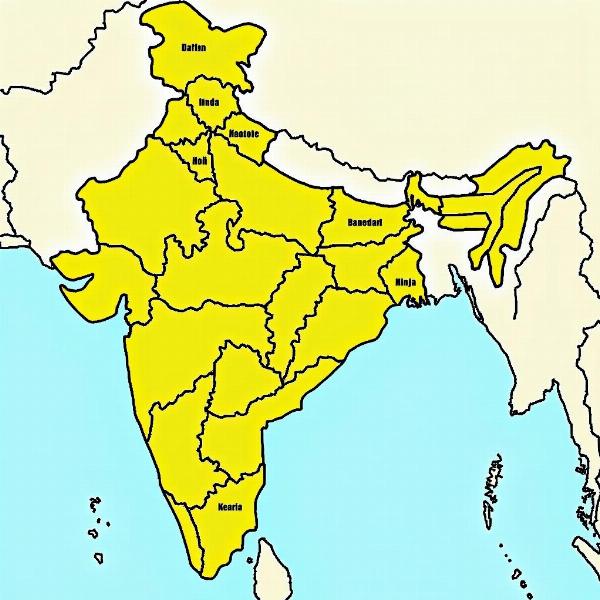Cline meaning in Hindi can be a tricky concept to grasp, especially if you’re not familiar with linguistic terminology. This article will delve into the meaning, usage, and relevance of “cline” within the Hindi language context, offering a clear and comprehensive understanding for both language enthusiasts and those seeking translation assistance. We’ll explore various Hindi equivalents and discuss how “cline” applies to the rich tapestry of dialects and linguistic variations within India.
Understanding the Concept of Cline
A cline in linguistics refers to a gradual change in a single linguistic feature over a geographic area. Imagine a spectrum of colors blending seamlessly from one to another. Similarly, a cline represents a continuum of language features, like pronunciation or vocabulary, shifting gradually across regions. This concept helps us understand how dialects emerge and evolve, demonstrating the fluidity of language.
Cline Meaning in Hindi: Exploring Equivalents
While a single perfect Hindi equivalent for “cline” doesn’t exist, several terms capture its essence depending on the specific context. “क्रमिक परिवर्तन” (kramik parivartan), meaning “gradual change” or “क्रमिक विकास” (kramik vikas), meaning “gradual development,” can be used to convey the general idea. More specific terms might include “भाषिक प्रवणता” (bhashik pravnata), meaning “linguistic gradient,” when referring to pronunciation changes, or “शब्दावली का क्रमिक परिवर्तन” (shabdavali ka kramik parivartan), meaning “gradual change in vocabulary,” when focusing on lexical variations.
How Cline Applies to Hindi Dialects
Hindi, spoken across a vast and diverse region, exhibits numerous dialects, making the concept of cline particularly relevant. Consider the pronunciation of certain vowels or the usage of specific words. These features can vary subtly from one village to the next, eventually leading to significant differences across larger distances. This gradual shift illustrates the cline phenomenon within Hindi.
What are some examples of clines in Hindi?
The pronunciation of the retroflex consonants is a classic example. Their pronunciation can vary significantly across different regions, showcasing a clear cline. Similarly, vocabulary differences also demonstrate clinal variations, with certain words preferred in some areas and their synonyms used in others.
Why is understanding “cline” important in Hindi translation?
Recognizing the existence of clines is crucial for accurate and nuanced Hindi translation. Translators must be aware of regional variations to ensure the target language reflects the specific dialect and cultural context intended by the source text. This understanding avoids misinterpretations and ensures effective communication.
Cline and Linguistic Diversity in India
India’s linguistic landscape is incredibly diverse, with numerous languages and dialects coexisting. The concept of cline helps us understand the dynamic relationships between these languages, highlighting how they influence and borrow from one another. It also emphasizes the importance of preserving this rich linguistic heritage. your transaction has been declined meaning in hindi
 Linguistic Diversity Map of India and Cline
Linguistic Diversity Map of India and Cline
Conclusion
Understanding “cline meaning in Hindi” requires appreciating the dynamic nature of language and its gradual evolution across geographical regions. While a perfect one-to-one translation may not exist, the concept can be effectively conveyed using various Hindi equivalents depending on the specific context. Recognizing the importance of clines in Hindi dialects and the broader Indian linguistic context is essential for both language learners and translation professionals. This knowledge allows for more accurate and nuanced understanding of the richness and complexity of Hindi and its place within India’s vibrant linguistic tapestry.
FAQ
- What is the simplest way to explain “cline” in Hindi? क्रमिक परिवर्तन (kramik parivartan), meaning “gradual change,” is a simple way to explain the concept.
- Why are there no exact Hindi translations for “cline”? Like many specialized terms, “cline” describes a specific linguistic concept that doesn’t have a direct equivalent in everyday Hindi vocabulary.
- How can I identify a cline in Hindi? Listen for variations in pronunciation or vocabulary across different regions. If you notice gradual shifts in these features, you’re likely observing a cline.
- Is “cline” relevant only to Hindi? No, “cline” is a universal linguistic concept applicable to any language with regional variations.
- How does understanding “cline” benefit translators? It enables them to create translations that are accurate, culturally sensitive, and reflect the intended dialect of the source text. i am dying meaning in hindi
- Does the concept of “cline” apply to other Indian languages? Yes, clinal variations exist in many Indian languages, reflecting the country’s linguistic diversity.
- Where can I learn more about Hindi dialects and clines? Linguistic resources and academic publications specializing in Hindi and Indian languages offer further insights. sage hindi name
Meaning-Hindi.in is your trusted partner for professional Hindi translation services. We offer a comprehensive range of translation solutions, covering business, legal, technical, website localization, educational, and specialized fields. Our expert team ensures accurate and culturally sensitive translations, reflecting the nuances of different Hindi dialects. anent meaning in hindi sunao meaning in hindi Contact us today for your Hindi translation needs at [email protected] or +91 11-4502-7584. Meaning-Hindi.in is dedicated to bridging language barriers and facilitating effective communication.